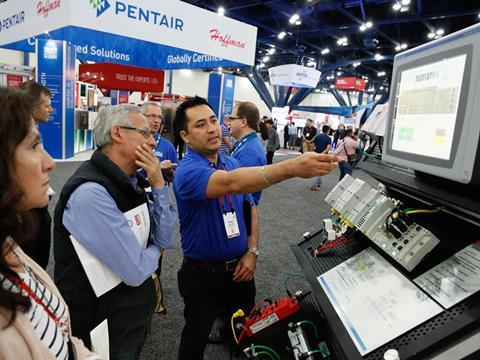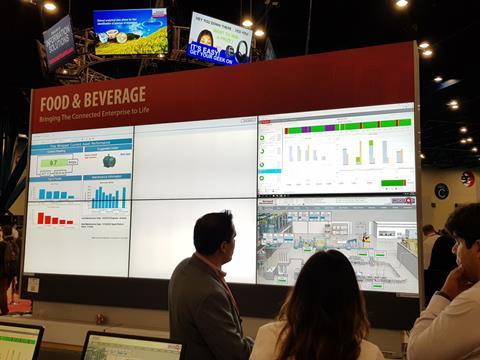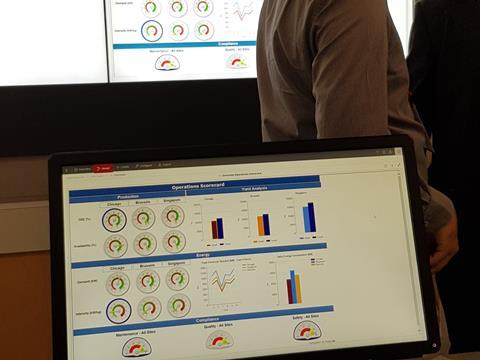
“Good things happen when we combine the potential of automation with the imagination of people,” remarked Blake Moret, president and CEO of Rockwell Automation, speaking at the opening of the 2017 edition of the annual Automation Fair in Houston. There’s a consensus around the industry that this was a year in which the smart manufacturing delivered on many if its promises of ‘good things’. Tim Sykes reports.
As the triennial preeminent event in the packaging calendar, interpack always serves as a snapshot of shifts and developments in the industry. Returning to Düsseldorf in May, I was struck by the sea-change in smart machinery capabilities across packaging and CPG since 2014. It was as if Industry 4.0 had moved from future tense to present tense. A similar sensation of time travel characterised my return to Rockwell’s Automation Fair two year’s after my last visit.
Where in 2015 in Chicago there had been extensive discussion of the need for manufacturers to rapidly acquire IT specialists with the skills to collate and interpret data from connected devices, recent innovations seem to have alleviated these industry anxieties.
Powerful analytics
Speaking at the Automation Perspectives conference, Frank Kulaszewicz, senior VP, Architecture & Software Division, Rockwell Automation, set out his vision of the digitally transformed enterprise, whose digital information thread provides context and critical insights enabling action to improve performance.
A key tool in this endeavour is the FactoryTalk platform: a powerful but easy to use analytics tool that enables businesses to take decisions closest to the source of data. The FactoryTalk platform provides scalable analytics, open to partner devices. The key advance here is in a move from descriptive and diagnostic analytics – the ‘what?’ data that requires user interpretation – towards an advanced analytics using tools that look for trends, leveraging models, machine learning and artificial intelligence.

FactoryTalk analytics encompasses data ingress, data visualisation and data orchestration, in other words means blending data to offer insights. Perhaps the single most impressive solution on display at Automation Fair was the customisable, user-friendly interface of the platform.
This is the fruit of Rockwell’s ‘Project Scio’ – an initiative to devise ways to enable businesses to create their own tailored analytics apps. “It’s possible to create an ad hoc ‘storyboard’ containing actionable information for each user,” explained Mr Kulaszewicz. “The dashboard is active, meaning the user can drill down and query information. However, it’s not necessary to build a new dashboard to access a piece of information: intelligent search functions enable the user to quickly access ‘orchestrated’ data, e.g. ‘sum of energy by machine’.”
The ability to mash up and simply present multiple internal and external data sources looks like a game-changer. So does FactoryTalk, as a tool that presents the crucial real-time and aggregated information needed by managers from machine operator and plant manager to the senior management at enterprise level.
Furthermore, to better connect industrial producers with expertise outside their production environment, Rockwell offers OEMs cloud-based machine analytics combining real-time with historical insights into how their equipment is operating, meaning they can collaborate with customers to help reduce downtime. At the enterprise level, companies can use the IDC as an IaaS offering or as a private, on-premises cloud platform. FactoryTalk Cloud, a public, remotely administered cloud platform powered by Windows Azure, helps monitor remote assets, meaning that OEMs can efficiently monitor and support machines after they are deployed with customers.

Digital design and mixed reality
A key tenet of the digital transformation vision is the principle of design and operation as a circular process. In machine production digital design uses a digital twin to test, validating designs and concepts before production. Machine builder libraries now enable a drag and drop approach rather than writing code. This drastically accelerates the process. Meanwhile, the use of digital pilots enhances value streams with asset management, enterprise risk and operational productivity.
On the Automation Fair show floor two solutions stood out among the 140 exhibits as examples of the opportunities for packaging. The first was a Cama packaging machine using digital twin visualisation, offering enhanced predictive maintenance, covering metrics such as torque, heat and revolutions. Through a HoloLens interface one can step inside the machine, interrogate and control each element. As managing director Billy Goodman remarked, in the past when efficiency has gradually declined it hasn’t always been noticed. With today’s toolkit it’s possible the operator is more intimately connected with the nuances of performance – delivering increased efficiency, flexibility and speed.
Secondly, Bradman Lake’s president Ian McDermott introduced the innovative machine builder’s latest independent motion side load cartoner, featuring full ethnet/IP architecture for ControlLogix controllers, Kinetix 5500 servo drives, PowerFlex variable frequency drives and PanelView HMIs. Guided pockets are individually controlled using iTRACK, and with internal collating additional robotics are not required by this footprint-shrinking solution. Meanwhile, it offers mixed reality machine intelligence, using FactoryTalk, Shelby and HoloLens to deliver a swathe of real-time interaction – immersive and hands free. Mr McDermott suggested that future R&D is likely to build further added value onto this platform, with extensions including linking to spare parts inventory.
Packaged goods
Another change since 2015 has been in Rockwell’s own attitude to the marketplace. “Previously segments would produce products and then work out where to apply them,” explained Mike Wagner (global OEM business manager). “Last year we made a so-called ‘pivot to industry’, a shift to verticals. Under our new approach business plans for key markets, including CPG, are built around trends and demands. Macro trends are tracked and translated into a tech roadmap, informing our R&D focus.”
The pivot also means becoming more engaged in the production challenges of the key markets, as exemplified by Rockwell’s experience with new customer Kraft Heinz’s ORE-IDA (a leading North American French fry brand). “We helped ORE-IDA produce a rigorous business plan that proved the returns that justified investment in modernisation of one line,” Mr Wagner continued. “The optimisation resulted in significant reduction of flow disruption, increased product yield, and reduced variation and scrap. This value has allowed for subsequent investment in further line optimisation.”
Becoming more market- and less solution-orientated inevitably involves speaking more fluently in the language of selling value. “This is what automation solutions are about,” remarked Mr Wagner. Smart sensors are about managing efficiency, for example measuring the degradation of a process. If a machine can send a message about a blockage, or better still automatically blow a puff of air to clean it out, this can prevent a stoppage or eliminate the need for costly, permanent air flow.”
Today’s demographic changes are driving lots of trends – including healthier foods, convenience, freshness, single-serve and ethnic offerings – that together spell out a proliferation of SKUs, requiring adaptive lines and faster changeovers. This can only continue to drive demand for scalable solutions bringing about digital optimisation of manufacturing in the food and beverage market. Given the pace at which smart technologies are advancing, it’s scary to imagine where we’ll be in another two years.

















